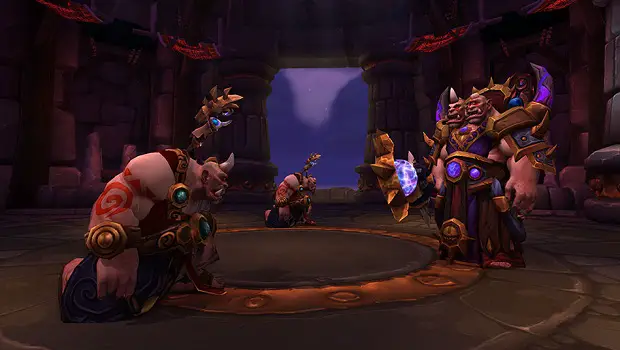Officers’ Quarters: Little more than peasants

Welcome to the new Officers’ Quarters! This week I’m answering (some of) the questions that you asked in the comments for my first Blizzard Watch column. You asked many more questions than I could handle in one feature. This is a good thing — it means I can sustain this format. Please do keep them coming, however. I will get to them all in time. I also appreciate feedback on this new format.
OK, here we go…
Honestly, Imperator is a pain and he’s going to be even more painful for a guild like yours. Why? It’s such a long, long fight. My guild has had wipes on heroic Imperator that clock in upwards of 12 minutes and longer. Encounters like that are brutal for one night per week guilds because you can only fit in so many attempts per week. They tend to sap morale also — to many players, fights that extend beyond the 10-minute mark stop feeling epic and start feeling tedious and mentally exhausting.
Higher ilevel gear from BRF will help you with him. Early BRF bosses like Gruul and Hans’gar and Franzok (if your guild can stomach the motion sickness issue) are relatively painless to learn and farm. Besides, hitting up a new raid is good for a change of pace after 2+ months of ogres.
I say get in there and see what you can do. When you hit a boss that seems like too much, then think about going back to Highmaul. Mar’gok will still be there, he’ll still be king, and you’ll still be little more than peasants (or so he’ll remind you on every pull).
This is really a question for the devs, not me! My experience so far in Warlords is that most normal and heroic bosses seem easier with fewer players. This is problematic for guilds who are trying to recruit up to 20, since bringing in more players can slow progression, which makes it harder to recruit. At the same time, it frustrates your existing raiders, who will grow impatient or even burn out faster. The scaling puts officers in an awkward position right now.
In general, I don’t think specific ilevel minimums are a good way to decide who can participate in raids. Too many other intangible factors like awareness, skill, attitude, and the ability to follow instructions are too important to ignore.
However, these other factors are not taken into account with your guild policies because you bring everyone. In this case, average ilevel is one indicator of recent raiding experience, so it can provide a neutral benchmark goal. 645 to 655 for normal and 660 to 670 for heroic are fair, achievable numbers that indicate a raider is ready to step into the respective BRF version. You may need to skew these numbers toward the high end to compensate for the players who are less skilled than an average raider.
Just keep in mind that if you stop running Highmaul, you’ll limit players’ ability to gear up for BRF so you should take this into account.
Oh my, yes. My guild has had to make this adjustment, too. Our 10-man heroic raids in Mists were collaborative and, dare I say, intimate. Each role had just a few players and we all worked together to troubleshoot strategies, call out mechanics, etc. Now sometimes we have more than 20 people and you just can’t have that kind of free for all anymore. It’s too distracting.
There are a few ways to manage this. All of them involve setting some new ground rules.
- Assign one player (most often the raid leader) to describe the strategy the raid will execute. Make further assignments for each mechanic that your raid wants to call out. Allow only those players to speak over voice chat during encounters, barring emergencies.
- Encourage players to whisper a raid leader or officer with strategy ideas instead of broadcasting them to the entire raid. This will reduce strategy arguments over voice chat. As a bonus, the leaders may also get more honest feedback this way, since players are often reluctant to call people out publicly but may whisper you that “So-and-so doesn’t know how to avoid getting pinned by spears. Can you make sure he understands it?”
- Ask players to type comments more often instead of speaking. A good way to separate chat is to post raid-relevant comments in the /ra channel and social comments in /g or /s. That way, it’s easy for players to see only the information that’s important and filter out the rest if they want to.
- Allow free chat while clearing trash or waiting for players to get ready to pull. Raiding is supposed to be fun, after all, and some good-natured joking and conversation between bosses helps lighten the mood. The raid leader should reserve the right to take over chat at any point, however, if a pull starts to go downhill, such as aggroing extra groups, losing a tank, etc.
/salute
Please consider supporting our Patreon!
Join the Discussion
Blizzard Watch is a safe space for all readers. By leaving comments on this site you agree to follow our commenting and community guidelines.
 @QuestVendor
@QuestVendor



